Characterization of Nitrogen Dioxide Variability Using Ground-Based and Satellite Remote Sensing and In Situ Measurements in the Tiber Valley (Lazio, Italy)
Abstract
:1. Introduction
2. Materials and Methods
2.1. Study Area
2.2. TROPOMI
2.3. Instruments at the Liberti Observatory
2.3.1. Pandora 2S
2.3.2. Chemiluminescence NOx Analyzer
2.3.3. Meteorological Station
2.4. The Weather Research and Forecasting Model
2.5. Methods
2.5.1. Pre-Processing
2.5.2. Spatial–Temporal Variation of NO2 Surface Concentration
2.5.3. TROPOMI and Pandora Tropospheric VCD Products
2.5.4. Spatial–Temporal Variation of the Tropospheric TROPOMI VCD in the Tiber Valley
3. Results and Discussion
3.1. NO2 Surface Concentration at Ground Level
3.1.1. Seasonal Variations
3.1.2. Monthly Variations
3.1.3. Diurnal Variations
3.1.4. Weekday/Weekend Variations
3.2. Tropospheric NO2
3.2.1. P138 and TROPOMI Products at the Liberti Observatory
3.2.2. Tropospheric NO2 in the Tiber Valley
3.2.3. Tropospheric NO2 during Selected Events
4. Conclusions
Author Contributions
Funding
Data Availability Statement
Acknowledgments
Conflicts of Interest
Appendix A
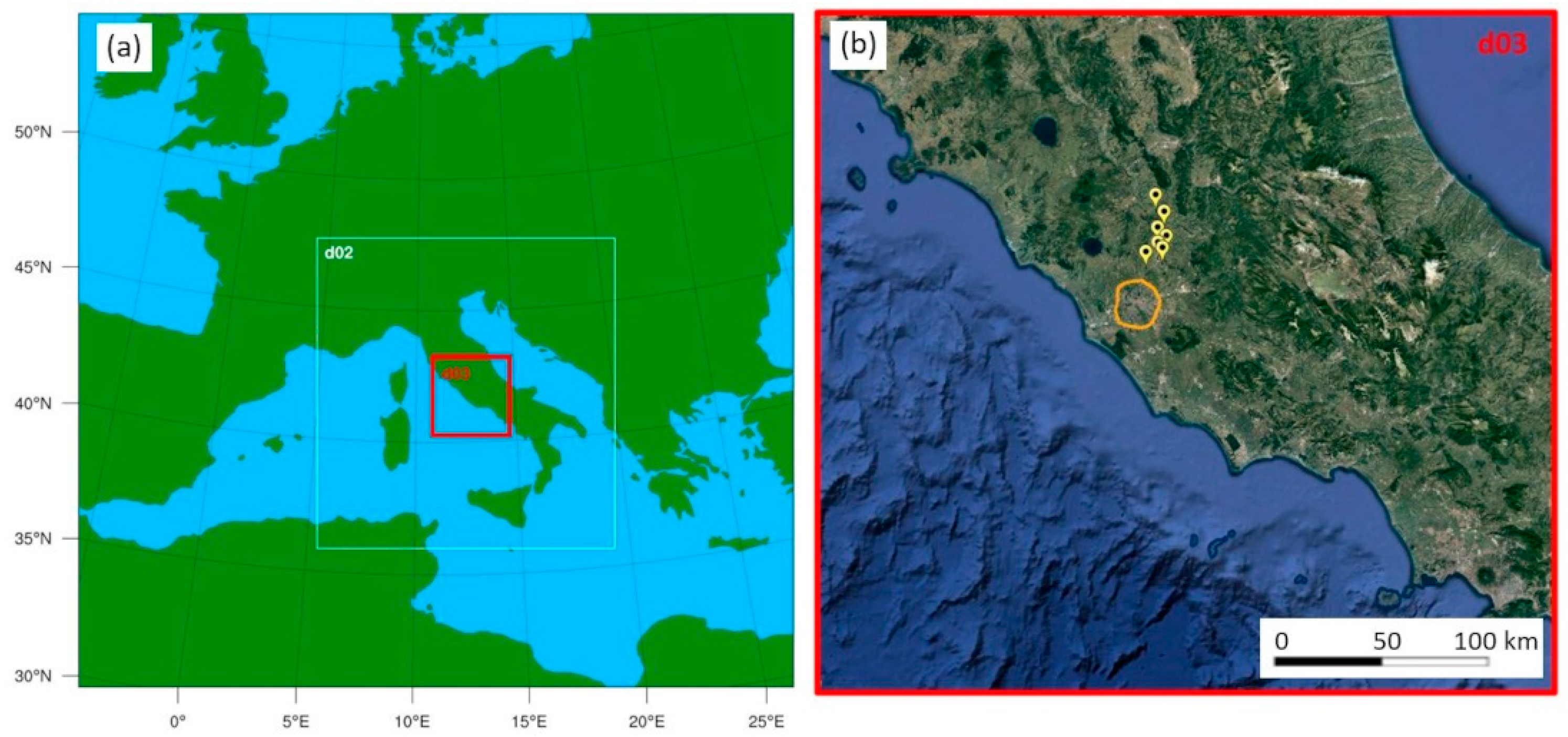
| Physics Category | Option |
|---|---|
| PBL scheme | Bougeault–Lacarrere |
| Urban scheme | Building Effect Parameterization (BEP) |
| Land-surface | Noah Land-Surface Model |
| surface-layer | Monin-Obukhov Similarity scheme |
| Microphysics | WSM 6-class graupel scheme |
| Longwave radiation | RRTM scheme |
| Shortwave radiation | Dudhia scheme |
| Land use dataset | MODIS |
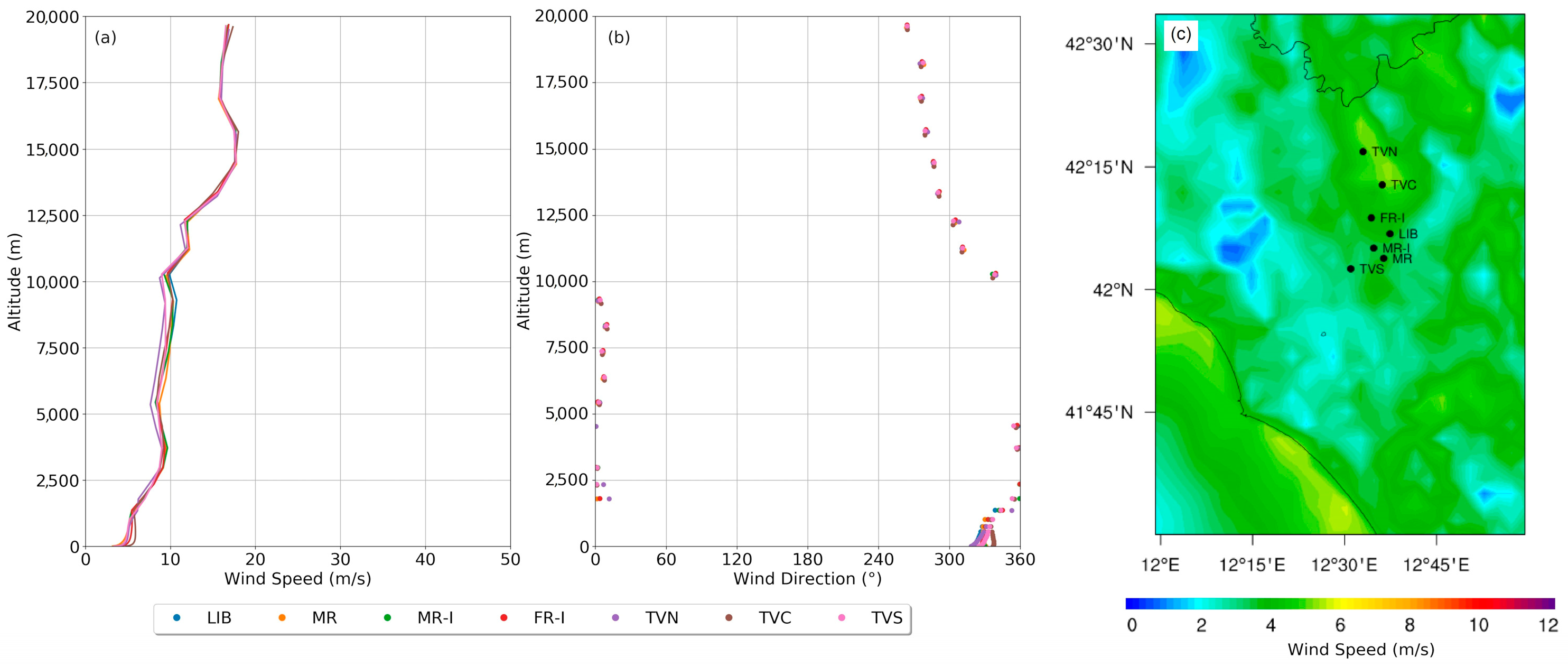
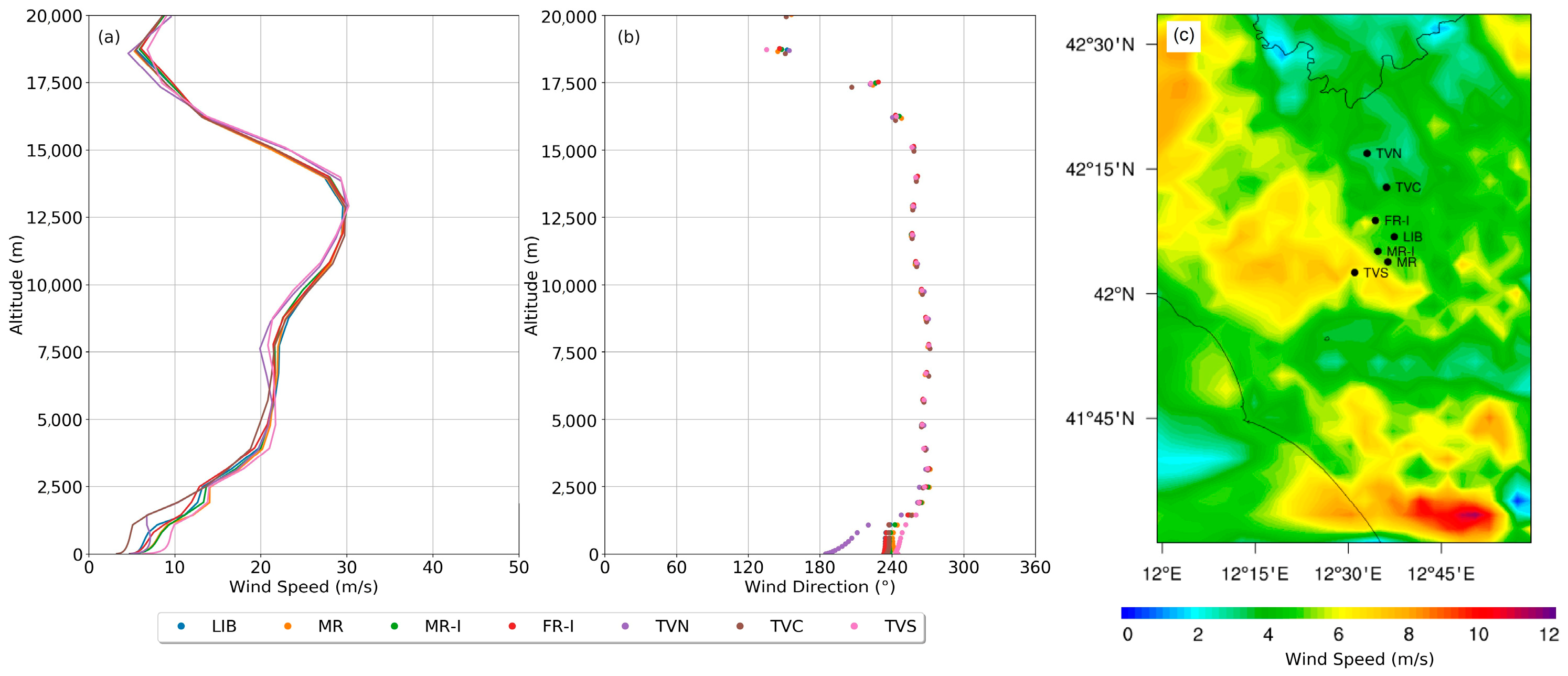
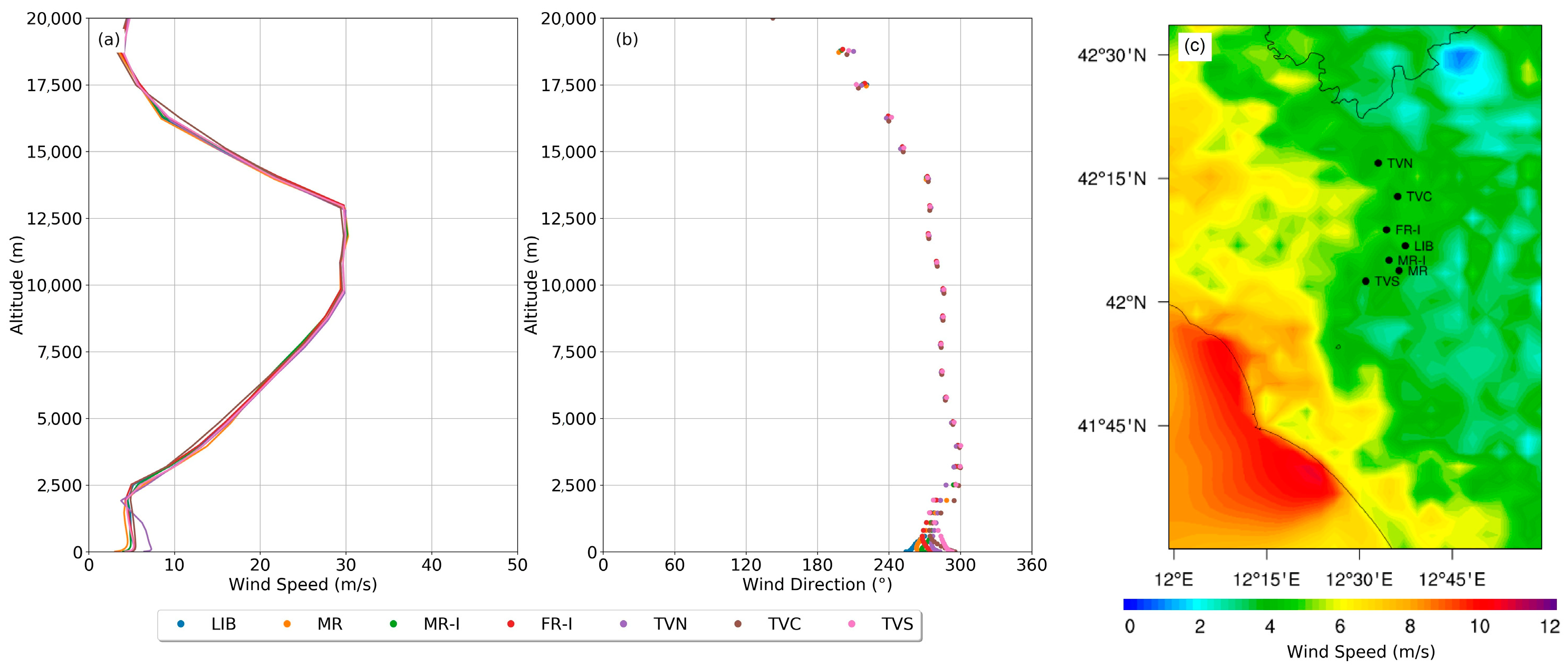

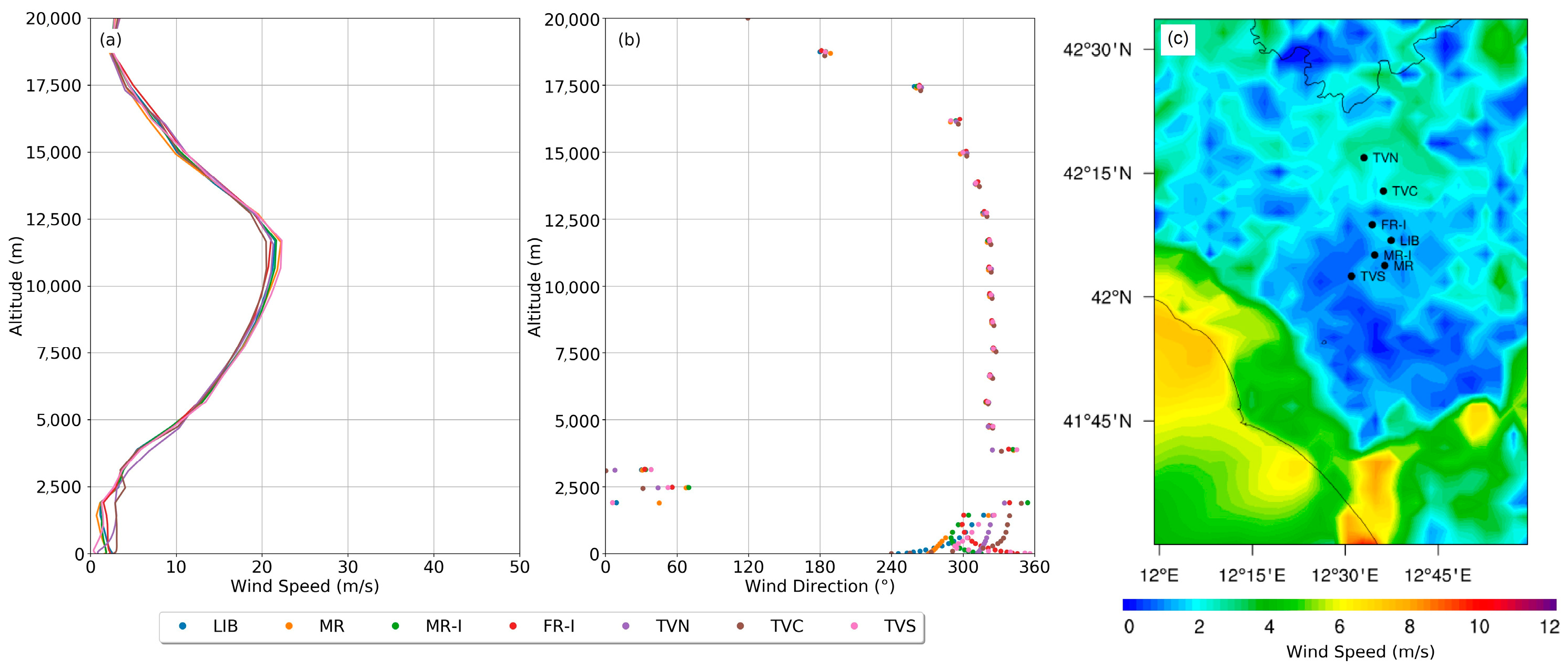
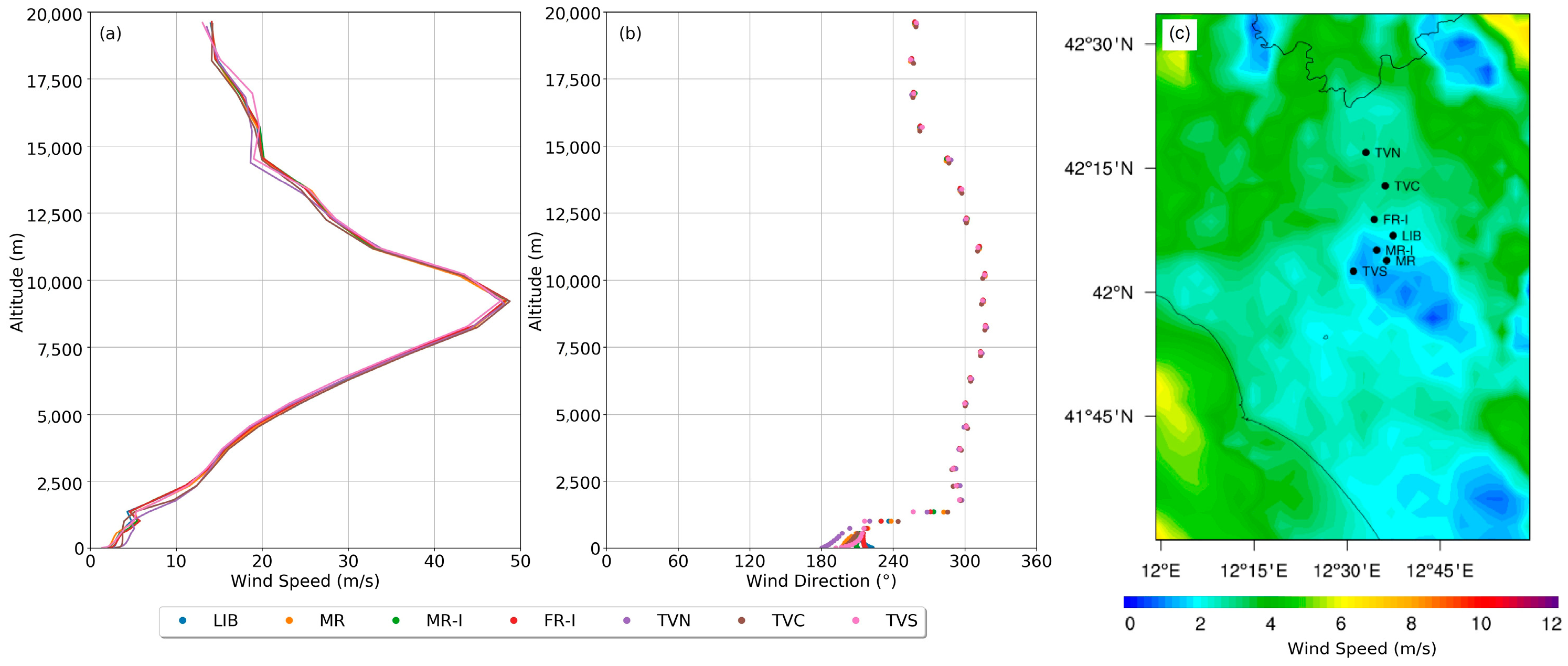

References
- Seinfeld, J.H.; Pandis, S.N. Atmospheric Chemistry and Physics: From Air Pollution to Climate Change, 3rd ed.; John Wiley and Son: Hoboken, NJ, USA, 2016; ISBN 978-1-118-94740-1. [Google Scholar]
- World Health Organization (WHO). WHO Global Air Quality Guidelines: Particulate Matter (PM2.5 and PM10), Ozone, Nitrogen Dioxide, Sulfur Dioxide and Carbon Monoxide; World Health Organization, Regional Office for Europe: Geneva, Switzerland, 2021; Available online: https://apps.who.int/iris/handle/10665/345329 (accessed on 24 April 2023).
- Huangfu, P.; Atkinson, R. Long-term exposure to NO2 and O3 and all-cause and respiratory mortality: A systematic review and meta-analysis. Environ. Int. 2020, 144, 105998. [Google Scholar] [CrossRef]
- Orellano, P.; Reynoso, J.; Quaranta, N.; Bardach, A.; Ciapponi, A. Short-term exposure to particulate matter (PM10 and PM2.5), nitrogen dioxide (NO2), and ozone (O3) and all-cause and cause-specific mortality: Systematic review and meta-analysis. Environ. Int. 2020, 142, 105876. [Google Scholar] [CrossRef] [PubMed]
- Zheng, X.-Y.; Orellano, P.; Lin, H.-L.; Jiang, M.; Guan, W.-J. Short-term exposure to ozone, nitrogen dioxide, and sulphur dioxide and emergency department visits and hospital admissions due to asthma: A systematic review and meta-analysis. Environ. Int. 2021, 150, 106435. [Google Scholar] [CrossRef] [PubMed]
- Velasco, R.P.; Jarosińska, D. Update of the WHO global air quality guidelines: Systematic reviews—An introduction. Environ. Int. 2022, 170, 107556. [Google Scholar] [CrossRef]
- European Environmental Agency (EEA). Air Quality in Europe 2023. In Europe’s Air Quality Status 2023—European Environment Agency; Report no. 05/2023; European Environmental Agency: Copenhagen, Denmark, 2023. Available online: europa.eu (accessed on 24 April 2023). [CrossRef]
- European Commission (EU). Communication from the Commission to the European Parliament, the Council, the European Economic and Social Committee and the Committee of the Regions. A Long-Term Vision for the EU’s Rural Areas—towards Stronger, Connected, Resilient and Prosperous Rural Areas by 2040. Brussels; 30.6.2021 COM (2021) 345 Final. Available online: https://eur-lex.europa.eu/legal-content/EN/TXT/?uri=CELEX:52021DC0345 (accessed on 24 April 2023).
- Griffin, D.; Zhao, X.; McLinden, C.A.; Boersma, F.; Bourassa, A.; Dammers, E.; Degenstein, D.; Eskes, H.; Fehr, L.; Fioletov, V.; et al. High-resolution mapping of nitrogen dioxide with TROPOMI: First results and validation over the Canadian oil sands. Geophys. Res. Lett. 2019, 46, 1049–1060. [Google Scholar] [CrossRef] [Green Version]
- Pseftogkas, A.; Koukouli, M.-E.; Segers, A.; Manders, A.; Geffen, J.V.; Balis, D.; Meleti, C.; Stavrakou, T.; Eskes, H. Comparison of S5P/TROPOMI Inferred NO2 Surface Concentrations with In Situ Measurements over Central Europe. Remote Sens. 2022, 14, 4886. [Google Scholar] [CrossRef]
- Müller, I.; Erbertseder, T.; Taubenböck, H. Tropospheric NO2: Explorative analyses of spatial variability and impact factors. Remote Sens. Environ. 2022, 270, 112839. [Google Scholar] [CrossRef]
- Goldberg, D.L.; Anenberg, S.C.; Kerr, G.H.; Mohegh, A.; Lu, Z.; Streets, D.G. TROPOMI NO2 in the United States: A detailed look at the annual averages, weekly cycles, effects of temperature, and correlation with surface NO2 concentrations. Earth’s Future 2021, 9, e2020EF001665. [Google Scholar] [CrossRef]
- Jeong, U.; Hong, H. Assessment of Tropospheric Concentrations of NO2 from the TROPOMI/Sentinel-5 Precursor for the Estimation of Long-Term Exposure to Surface NO2 over South Korea. Remote Sens. 2021, 13, 1877. [Google Scholar] [CrossRef]
- Pandonia Global Network (PGN). Available online: https://www.pandonia-global-network.org/ (accessed on 24 April 2023).
- Verhoelst, T.; Compernolle, S.; Pinardi, G.; Lambert, J.-C.; Eskes, H.J.; Eichmann, K.-U.; Fjæraa, A.M.; Granville, J.; Niemeijer, S.; Cede, A.; et al. Ground-based validation of the Copernicus Sentinel-5P TROPOMI NO2 measurements with the NDACC ZSL-DOAS, MAX-DOAS and Pandonia global networks. Atmos. Meas. Tech. 2021, 14, 481–510. [Google Scholar] [CrossRef]
- Ialongo, I.; Virta, H.; Eskes, H.; Hovila, J.; Douros, J. Comparison of TROPOMI/Sentinel-5 Precursor NO2 observations with ground-based measurements in Helsinki. Atmos. Meas. Tech. 2020, 13, 205–218. [Google Scholar] [CrossRef] [Green Version]
- Zhao, X.; Griffin, D.; Fioletov, V.; McLinden, C.; Davies, J.; Ogyu, A.; Lee, S.C.; Lupu, A.; Moran, M.D.; Cede, A.; et al. Retrieval of total column and surface NO2 from Pandora zenith-sky measurements. Atmos. Chem. Phys. 2019, 19, 10619–10642. [Google Scholar] [CrossRef]
- Cede, A. Manual for Blick Software Suite 1.8; Version 1-8-4; Luftblick: Innsbruck, Austria, 2021; pp. 183–185. Available online: https://www.pandonia-global-network.org/wp-content/uploads/2021/09/BlickSoftwareSuite_Manual_v1-8-4.pdf (accessed on 24 April 2023).
- Bassani, C.; Vichi, F.; Esposito, G.; Montagnoli, M.; Giusto, M.; Ianniello, A. Nitrogen dioxide reductions from satellite and surface observations during COVID-19 mitigation in Rome (Italy). Environ. Sci. Pollut. Res. 2021, 28, 22981–23004. [Google Scholar] [CrossRef]
- Boundary-Layer Air Quality-Analysis Using Network of Instruments (BAQUNIN) Super-Site. Available online: https://www.baqunin.eu/ (accessed on 24 April 2023).
- Iannarelli, A.M.; Di Bernardino, A.; Casadio, S.; Bassani, C.; Cacciani, M.; Campanelli, M.; Casasanta, G.; Cadau, E.; Diémoz, H.; Mevi, G.; et al. The Boundary Layer Air Quality-Analysis Using Network of Instruments (BAQUNIN) Supersite for Atmospheric Research and Satellite Validation over Rome Area. Bull. Am. Meteorol. Soc. 2022, 103, E599–E618. [Google Scholar] [CrossRef]
- Yttri, K.E.; Simpson, D.; Bergström, R.; Kiss, G.; Szidat, S.; Ceburnis, D.; Eckhardt, S.; Hueglin, C.; Nøjgaard, J.K.; Perrino, C.; et al. The EMEP Intensive Measurement Period campaign, 2008–2009: Characterizing carbonaceous aerosol at nine rural sites in Europe. Atmos. Chem. Phys. 2019, 19, 4211–4233. [Google Scholar] [CrossRef] [Green Version]
- Ciccioli, P.; Brancaleoni, E.; Frattoni, M. Chapter 5—Reactive Hydrocarbons in the Atmosphere at Urban and Regional Scales. In Reactive Hydrocarbons in the Atmosphere; Hewitt, C.N., Ed.; Academic Press: Cambridge, MA, USA, 1999; pp. 159–207. [Google Scholar] [CrossRef]
- Veefkind, J.P.; Aben, I.; McMullan, K.; Forster, H.; de Vries, J.; Otter, G.; Claas, J.; Eskes, H.J.; de Haan, J.F.; Kleipool, Q.; et al. TROPOMI on the ESA Sentinel-5 Precursor: A GMES mission for global observations of the atmospheric composition for climate, 30 air quality and ozone layer applications. Remote Sens. Environ. 2012, 120, 70–83. [Google Scholar] [CrossRef]
- van Geffen, J.H.G.M.; Eskes, H.J.; Boersma, K.F.; Veefkind, J.P. TROPOMI ATBD of the Total and Tropospheric NO2 Data Products; Tech Rep S5P-KNMI-L2-0005-RP; CI-7430-ATBD, Issue 2.4.0; Koninklijk Nederlands Meteorologisch Instituut (KNMI): De Bilt, The Netherlands, 2022; Available online: https://sentinel.esa.int/documents/247904/2476257/sentinel-5p-tropomi-atbd-no2-data-products (accessed on 24 April 2023).
- Eskes, H.; van Geffen, J.; Boersma, F.; Eichmann, K.-U.; Apituley, A.; Pedergnana, M.; Sneep, M.; Veefkind, J.P.; Loyola, D. Sentinel-5 Precursor/TROPOMI Level 2 Product User Manual Nitrogen Dioxide, V.4.1.0 (S5P-KNMI-L2-0021-MA). 2022. Available online: https://sentinel.esa.int/documents/247904/2474726/Sentinel-5P-Level-2-Product-User-Manual-Nitrogen-Dioxide.pdf (accessed on 24 April 2023).
- van Geffen, J.; Boersma, F.K.; Eskes, H.; Sneep, M.; Linden, T.M.; Zara, M.; Veefkind, P.J. S5P TROPOMI NO2 slant column retrieval: Method, stability, uncertainties and comparisons with OMI. Atmos. Meas. Tech. 2020, 13, 1315–1335. [Google Scholar] [CrossRef] [Green Version]
- Boersma, K.F.; Eskes, H.J.; Brinksma, E.J. Error analysis for tropospheric NO2 retrieval from space. J. Geophys. Res. 2004, 109, D0431. [Google Scholar] [CrossRef]
- Platt, U.; Stutz, J. Differential Optical Absorption Spectroscopy—Principles and Application, 1st ed.; Springer: Berlin/Heidelberg, Germany, 2008. [Google Scholar] [CrossRef] [Green Version]
- Williams, J.E.; Boersma, K.F.; Le Sager, P.; Verstraeten, W.W. The high-resolution version of TM5-MP for optimized satellite retrievals: Description and validation. Geosci. Model Dev. 2017, 10, 721–750. [Google Scholar] [CrossRef] [Green Version]
- Kleipool, Q.L.; Dobber, M.R.; de Haan, J.F.; Levelt, P.F. Earth surface reflectance climatology from 3 years of OMI data. J. Geophys. Res. Atmos. 2008, 113, D18308. [Google Scholar] [CrossRef] [Green Version]
- Herman, J.; Cede, A.; Spinei, E.; Mount, G.; Tzortziou, M.; Abuhassan, N. NO2 column amounts from ground-based Pandora and MFDOAS spectrometers using the direct-sun DOAS technique: Intercomparisons and application to OMI validation. J. Geophys. Res. 2009, 114, D13307. [Google Scholar] [CrossRef] [Green Version]
- EN 14211:2012; Ambient Air Standard Method for the Measurement of the Concentration of Nitrogen Dioxide and Nitrogen Monoxide by Chemiluminescence. European Committee for Standardization: Brussels, Belgium, 2012.
- Winer, A.M.; Peters, J.W.; Smith, J.P.; Pitts, J.N. Response of commercial chemiluminescent nitric oxide-nitrogen dioxide analyzers to other nitrogen-containing compounds. Environ. Sci. Technol. 1974, 8, 1118–1121. [Google Scholar] [CrossRef]
- Steinbacher, M.; Zellweger, C.; Schwarzenbach, B.; Bugmann, S.; Buchmann, B.; Ordonez, C.; Prévot, A.S.H.; Hueglin, C. Nitrogen oxide measurements at rural sites in Switzerland: Bias of conventional measurement techniques. J. Geophys. Res. 2007, 112, D11307. [Google Scholar] [CrossRef] [Green Version]
- Gerboles, M.; Lagler, F.; Rembges, D.; Brun, C. Assessment of uncertainty of NO2 measurements by the chemiluminescence method and discussion of the quality objective of the NO2 European Directive. J. Environ. Monit. 2003, 5, 529–540. [Google Scholar] [CrossRef]
- Andersen, S.T.; Carpenter, L.J.; Nelson, B.S.; Neves, L.; Read, K.A.; Reed, C.; Ward, M.; Rowlinson, M.J.; Lee, J.D. Long-term NOx measurements in the remote marine tropical troposphere. Atmos. Meas. Tech. 2021, 14, 3071–3085. [Google Scholar] [CrossRef]
- Skamarock, W.C.; Klemp, J.B.; Dudhia, J.; Gill, D.O.; Liu, Z.; Berner, J.; Wang, W.; Powers, J.G.; Duda, M.G.; Barker, D.M.; et al. A Description of the Advanced Research WRF Model Version 4.3 (No. NCAR/TN-556+STR). 2021. Available online: https://opensky.ucar.edu/islandora/object/opensky:2898 (accessed on 28 March 2023).
- National Centers for Environmental Prediction/National Weather Service/NOAA/U.S. Department of Commerce. NCEP GDAS/FNL 0.25 Degree Global Tropospheric Analyses and Forecast Grids. Research Data Archive at the National Center for Atmospheric Research, Computational and Information Systems Laboratory. 2015. Available online: https://rda.ucar.edu/datasets/ds083.3/ (accessed on 28 March 2023).
- Ashenden, T.W.; Bell, S.A. Rural concentrations of nitrogen dioxide pollution throughout Wales. Environ. Pollut. 1989, 58, 179–193. [Google Scholar] [CrossRef]
- Ashenden, T.W.; Edge, C.P. Increasing concentrations of nitrogen dioxide pollution in rural Wales. Environ. Pollut. 1995, 87, 11–16. [Google Scholar] [CrossRef]
- Bell, S.; Ashenden, T.W. Spatial and temporal variation in nitrogen dioxide pollution adjacent to rural roads. Water Air Soil Pollut. 1997, 95, 87–98. [Google Scholar] [CrossRef]
- Kenagy, H.S.; Sparks, T.L.; Ebben, C.J.; Wooldrige, P.J.; Lopez-Hilfiker, F.D.; Lee, B.H.; Thornton, J.A.; McDuffie, E.E.; Fibiger, D.L.; Brown, S.S.; et al. NOx lifetime and NOy partitioning during WINTER. J. Geophys. Res. Atmos. 2018, 123, 9813–9827. [Google Scholar] [CrossRef]
- Potter, P.; Ramankutty, N.; Bennett, E.M.; Donner, S.D. Characterizing the Spatial Patterns of Global Fertilizer Application and Manure Production. Earth Interact. 2010, 14, 1–22. [Google Scholar] [CrossRef]
- Huber, D.E.; Steiner, A.L.; Kort, E.A. Daily cropland soil NOx emissions identified by TROPOMI and SMAP. Geophys. Res. Lett. 2020, 47, e2020GL089949. [Google Scholar] [CrossRef]
- Luo, L.; Ran, L.; Rasool, Q.Z.; Cohan, D.S. Integrated Modeling of U.S. Agricultural Soil Emissions of Reactive Nitrogen and Associated Impacts on Air Pollution, Health, and Climate. Environ. Sci. Technol. 2022, 56, 9265–9276. [Google Scholar] [CrossRef]
- Di Bernardino, A.; Mevi, G.; Iannarelli, A.M.; Falasca, S.; Cede, A.; Tiefengraber, M.; Casadio, S. Temporal Variation of NO2 and O3 in Rome (Italy) from Pandora and In Situ Measurements. Atmosphere 2023, 14, 594. [Google Scholar] [CrossRef]
- Stavrakou, T.; Müller, J.F.; Bauwens, M.; Boersma, K.F.; van Geffen, J. Satellite evidence for changes in the NO2 weekly cycle over large cities. Sci. Rep. 2020, 10, 10066. [Google Scholar] [CrossRef]
- Beirle, S.; Platt, U.; Wenig, M.; Wagner, T. Weekly cycle of NO2 by GOME measurements: A signature of anthropogenic sources. Atmos. Chem. Phys. 2003, 3, 2225–2232. [Google Scholar] [CrossRef] [Green Version]
- Dimitropoulou, E.; Hendrick, F.; Pinardi, G.; Friedrich, M.M.; Merlaud, A.; Tack, F.; De Longueville, H.; Fayt, C.; Hermans, C.; Laffineur, Q.; et al. Validation of TROPOMI tropospheric NO2 columns using dual-scan multi-axis differential optical absorption spectroscopy (MAX-DOAS) measurements in Uccle, Brussels. Atmos. Meas. Tech. 2020, 13, 5165–5191. [Google Scholar] [CrossRef]
- Judd, L.M.; Al-Saadi, J.A.; Szykman, J.J.; Valin, L.C.; Janz, S.J.; Kowalewski, M.G.; Eskes, H.J.; Veefkind, J.P.; Cede, A.; Mueller, M.; et al. Evaluating Sentinel-5P TROPOMI tropospheric NO2 column densities with airborne and Pandora spectrometers near New York City and Long Island Sound. Atmos. Meas. Tech. 2020, 13, 6113–6140. [Google Scholar] [CrossRef] [PubMed]
- Herman, J.; Abuhassan, N.; Kim, J.; Kim, J.; Dubey, M.; Raponi, M.; Tzortziou, M. Underestimation of column NO2 amounts from the OMI satellite compared to diurnally varying ground-based retrievals from multiple PANDORA spectrometer instruments. Atmos. Meas. Tech. 2019, 12, 5593–5612. [Google Scholar] [CrossRef] [Green Version]
- Sentinel-4 Mission. Sentinel-4—Missions—Sentinel Online—Sentinel Online. Available online: copernicus.eu (accessed on 9 May 2023).
- Rudke, A.P.; Martins, J.A.; Hallak, R.; Martins, L.D.; de Almeida, D.S.; Beal, A.; Freitas, E.D.; Andrade, M.F.; Koutrakis, P.; Albuquerque, T.T.A. Evaluating TROPOMI and MODIS performance to capture the dynamic of air pollution in São Paulo state: A case study during the COVID-19 outbreak. Remote Sens. Environ. 2023, 289, 113514. [Google Scholar] [CrossRef]
- Petetin, H.; Guevara, M.; Compernolle, S.; Bowdalo, D.; Bretonnière, P.-A.; Enciso, S.; Jorba, O.; Lopez, F.; Soret, A.; Pérez García-Pando, C. Potential of TROPOMI for understanding spatio-temporal variations in surface NO2 and their dependencies upon land use over the Iberian Peninsula. Atmos. Chem. Phys. 2023, 23, 3905–3935. [Google Scholar] [CrossRef]
- Hu, X.-M.; Klein, P.M.; Xue, M. Evaluation of the updated YSU planetary boundary layer scheme within WRF for wind resource and air quality assessments. J. Geophys. Res. Atmos. 2013, 118, 10,490–10,505. [Google Scholar] [CrossRef]
- Falasca, S.; Gandolfi, I.; Argentini, S.; Barnaba, F.; Casasanta, G.; Di Liberto, L.; Petenko, I.; Curci, G. Sensitivity of near-surface meteorology to PBL schemes in WRF simulations in a port-industrial area with complex terrain. Atmos. Res. 2021, 264, 105824. [Google Scholar] [CrossRef]
- Martilli, A.; Clappier, A.; Rotach, M.W. An urban surface exchange parameterisation for mesoscale models. Bound. Layer Meteorol. 2002, 104, 261–304. [Google Scholar] [CrossRef]
- Falasca, S.; Zinzi, M.; Ding, L.; Curci, G.; Santamouris, M. On the mitigation potential of higher urban albedo in a temperate oceanic metropolis. Sustain. Cities Soc. 2022, 81, 103850. [Google Scholar] [CrossRef]
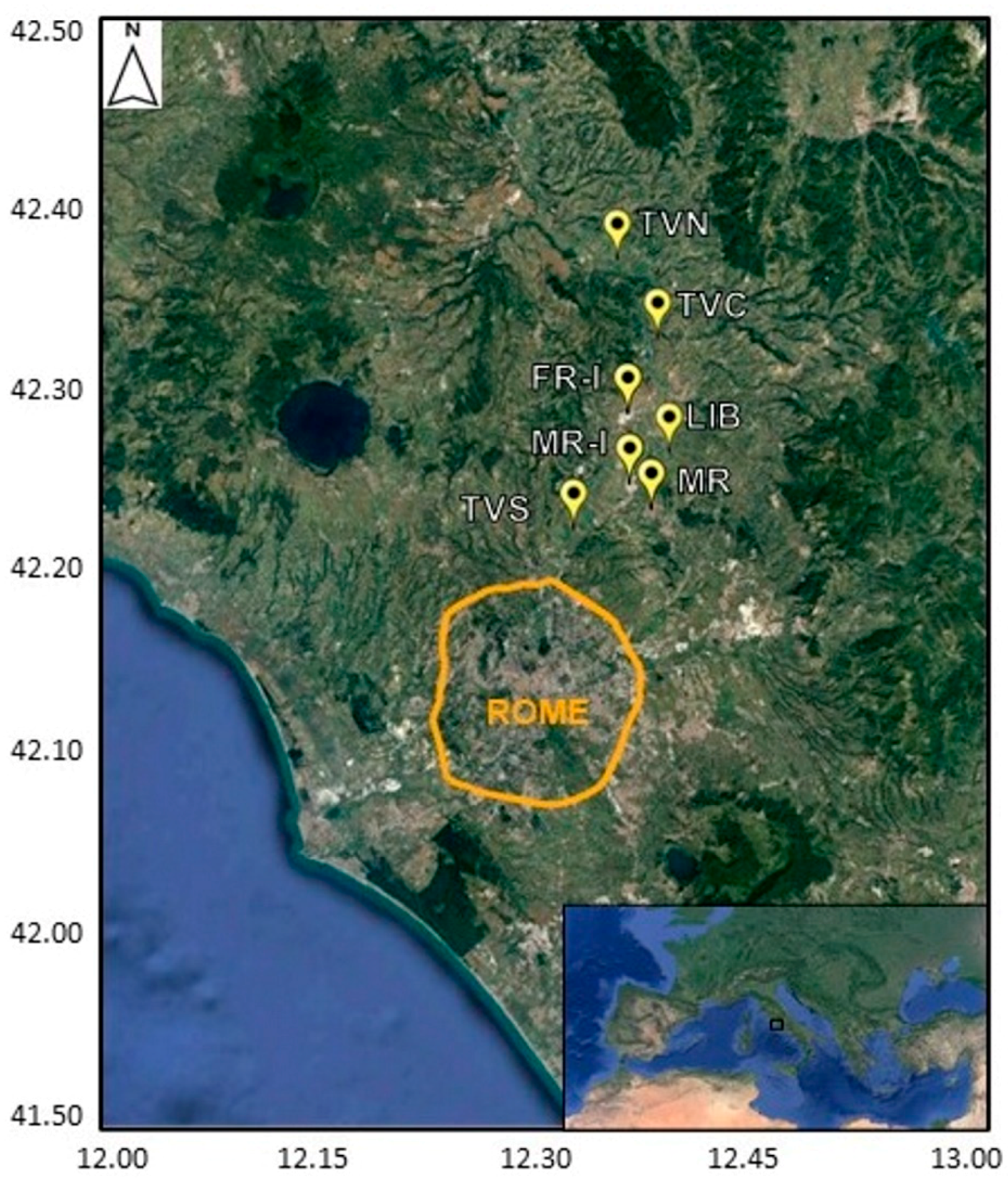
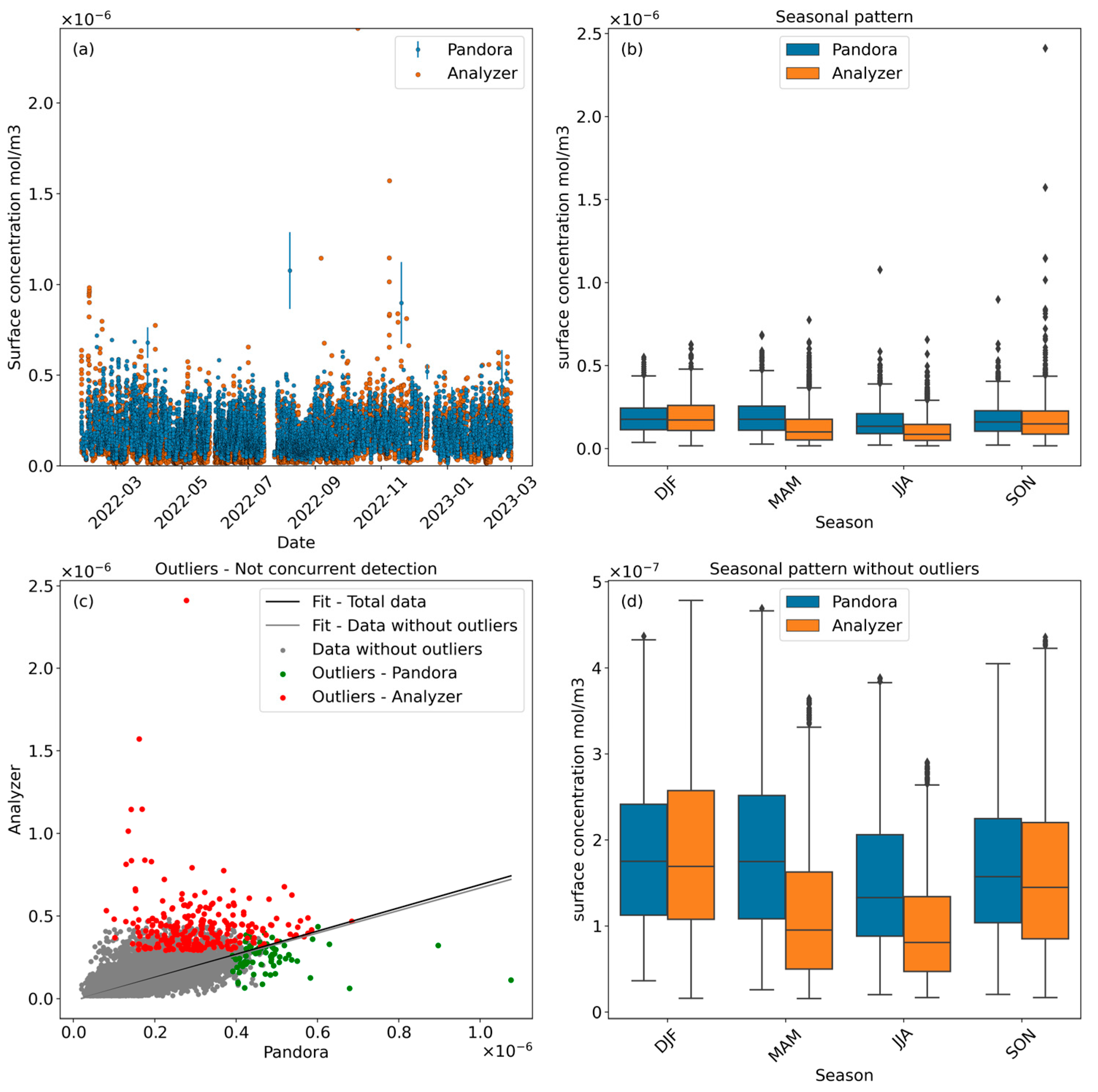


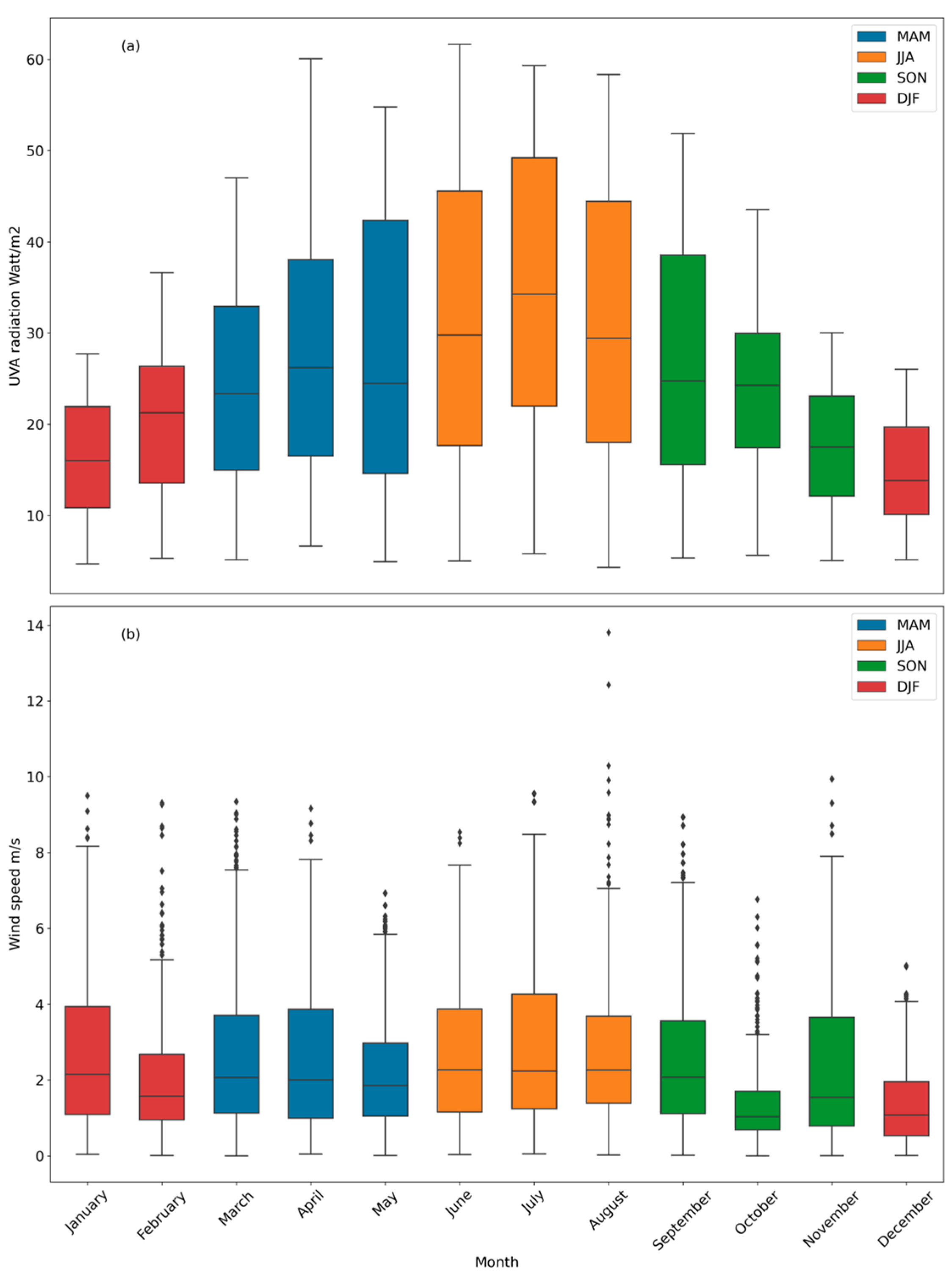
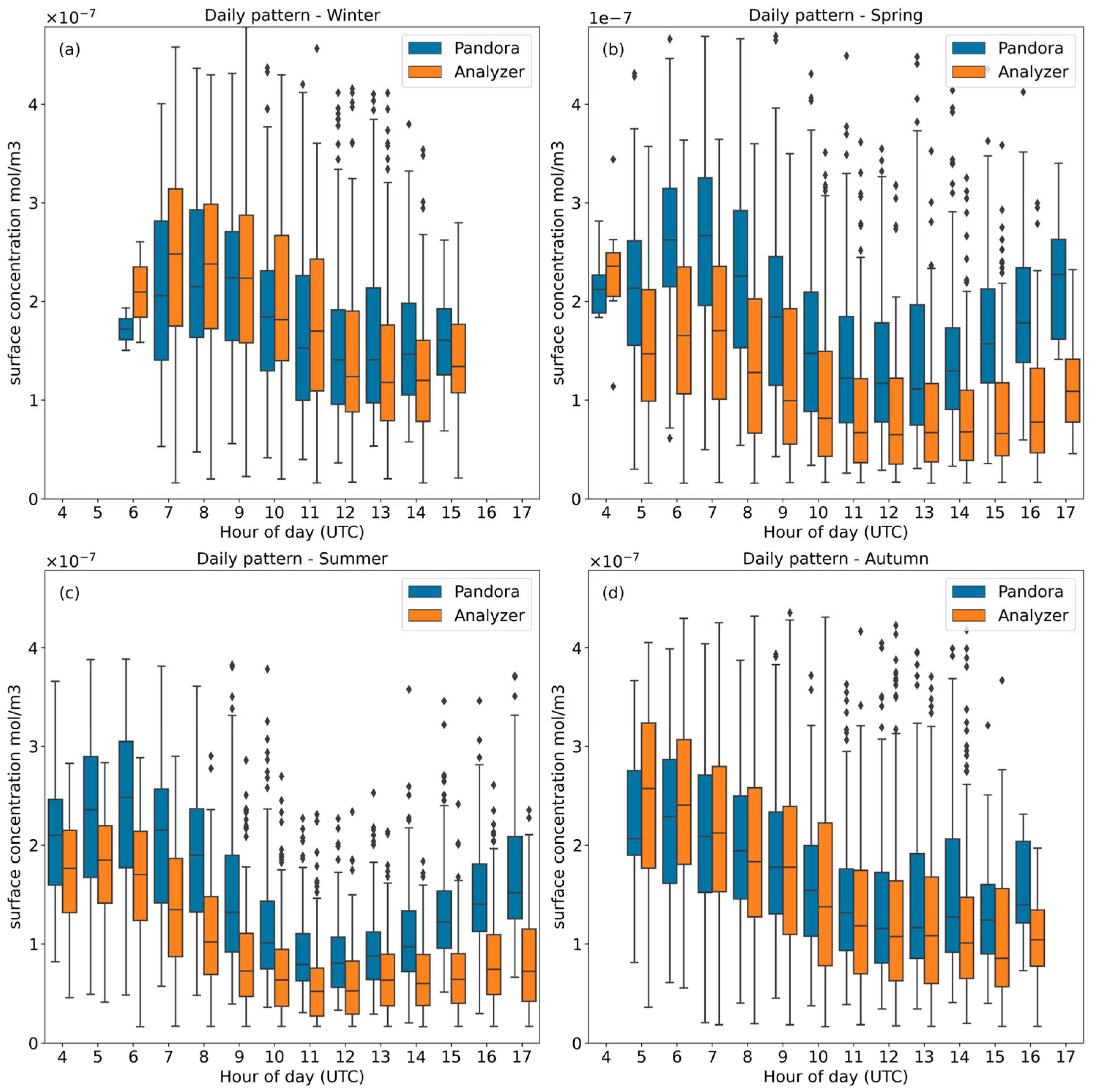
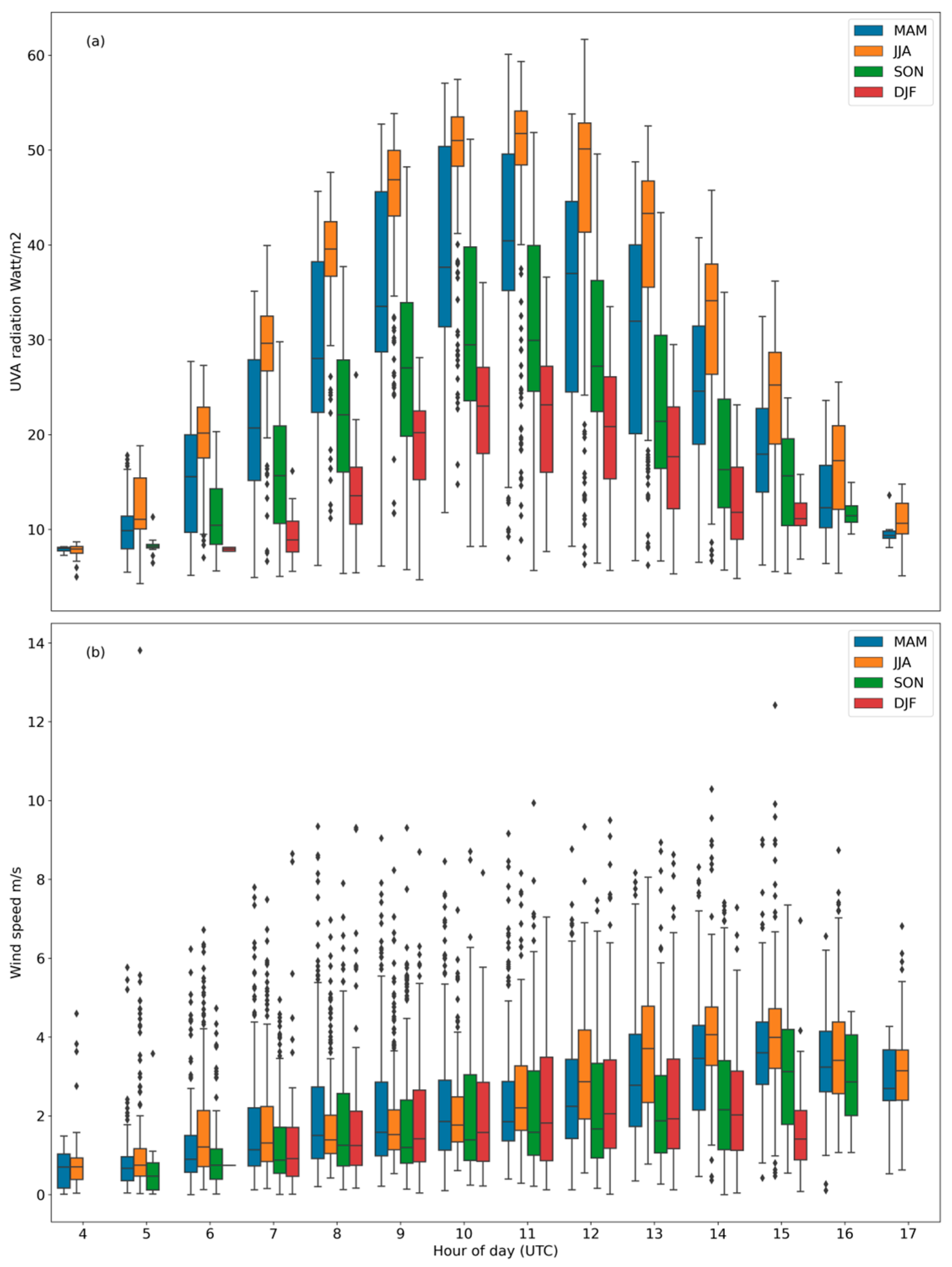
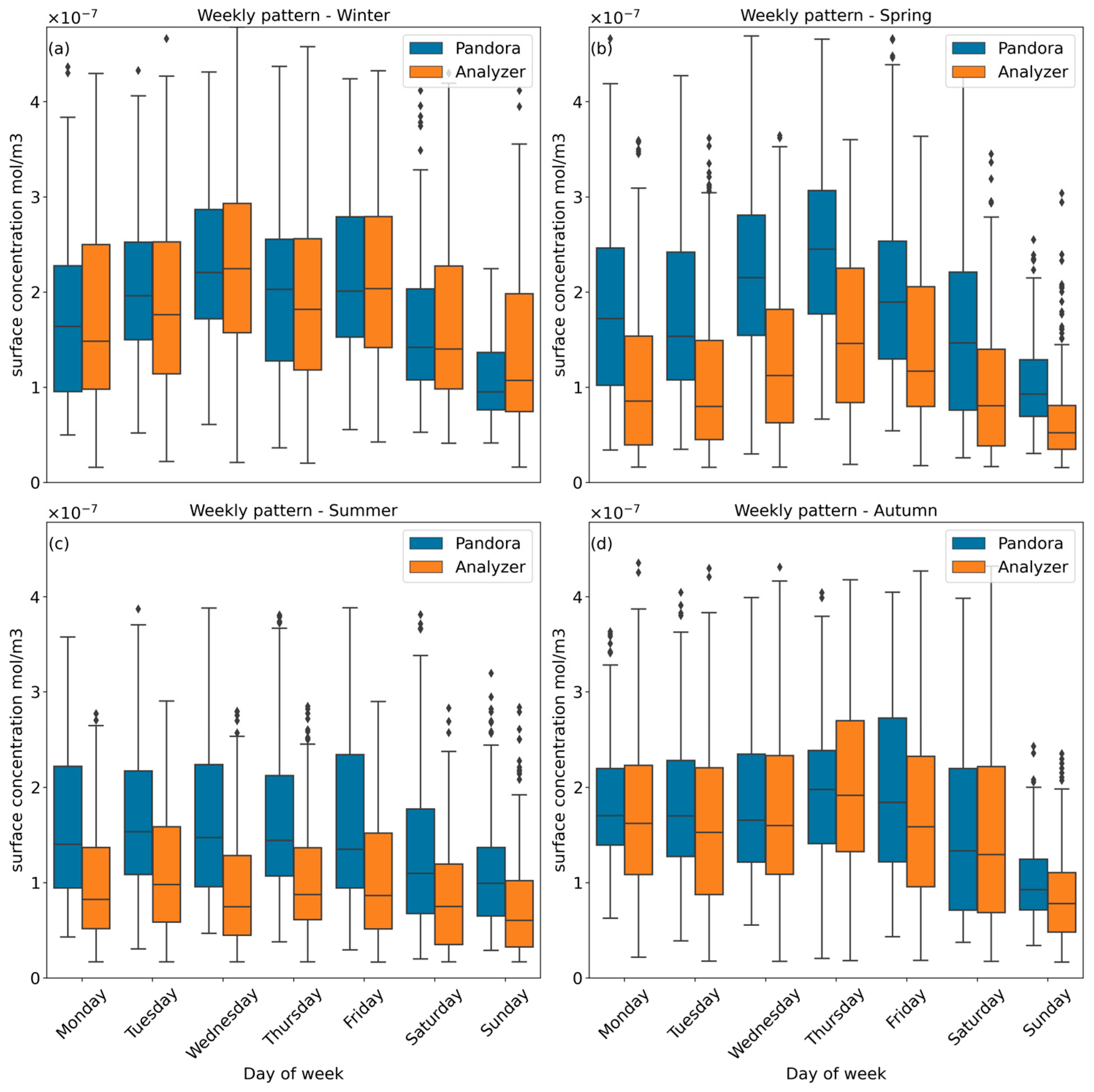
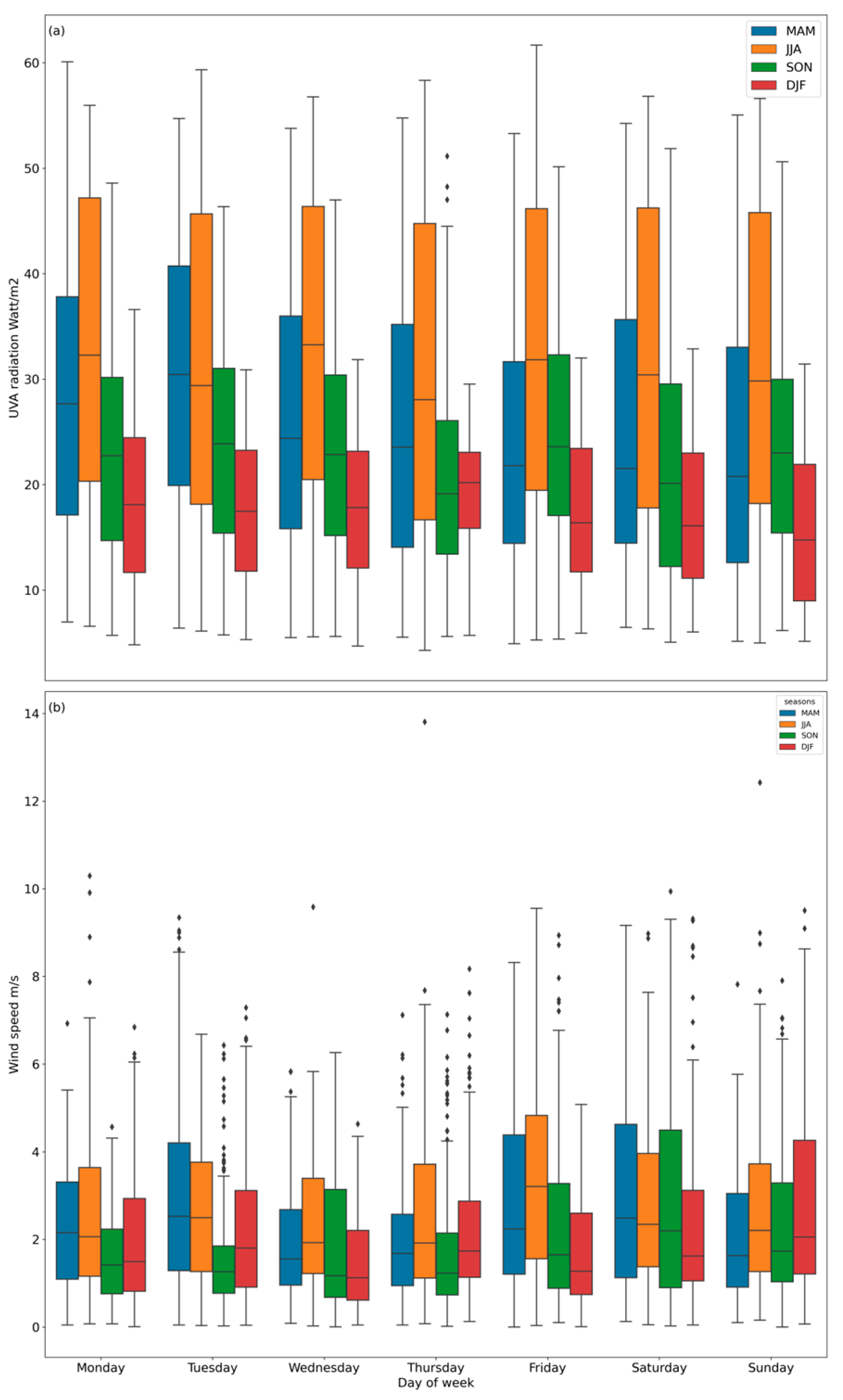
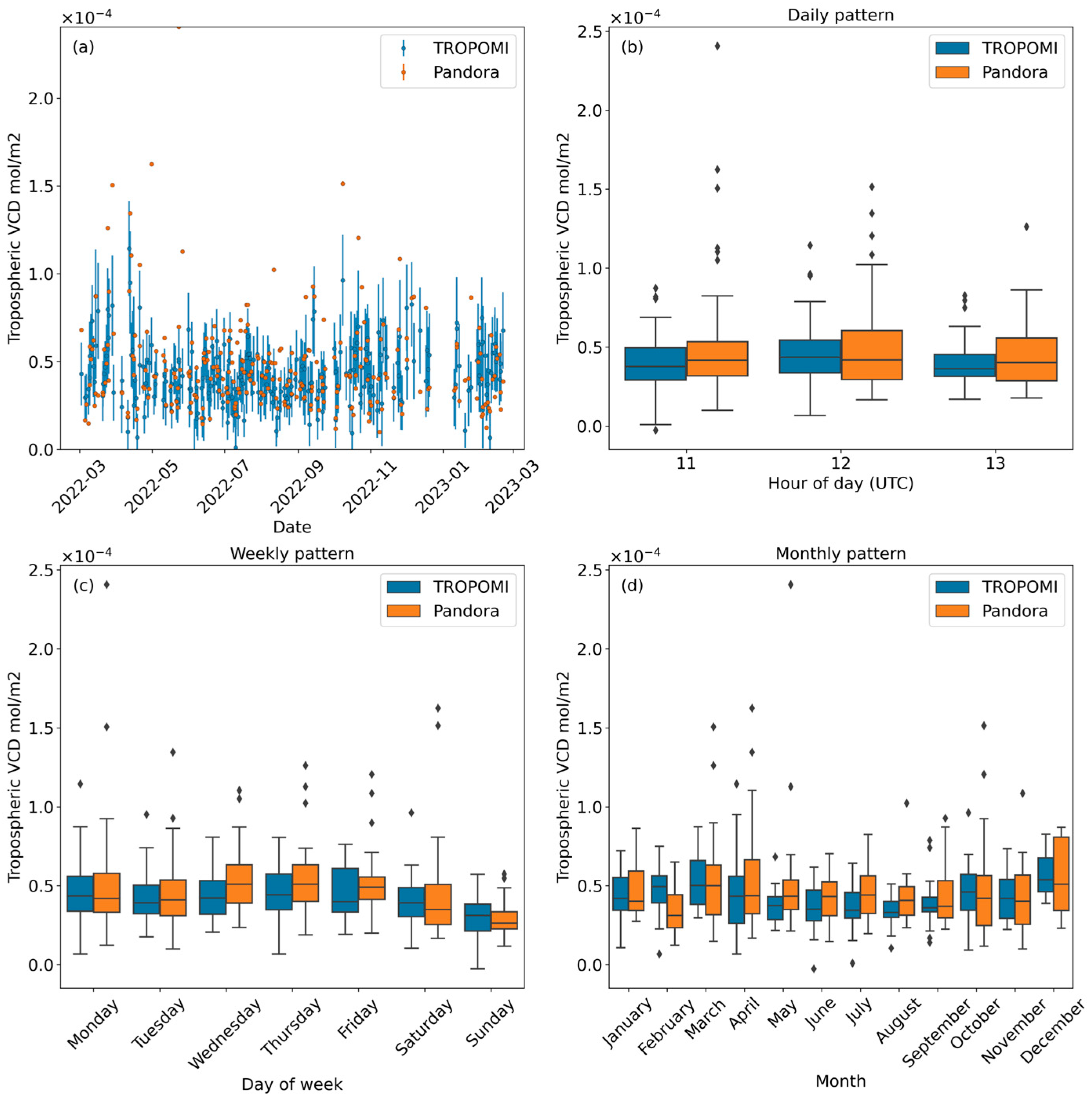
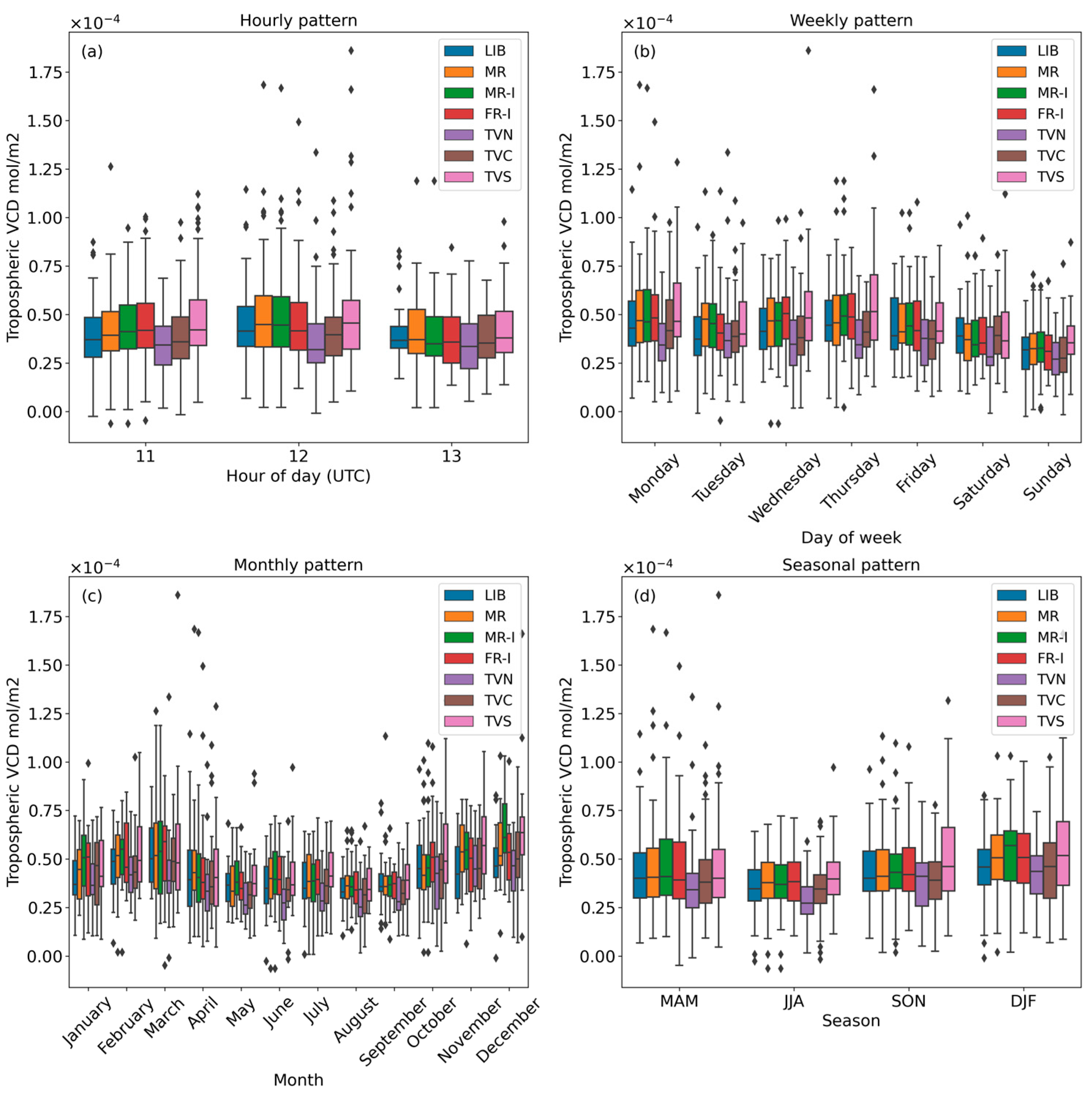

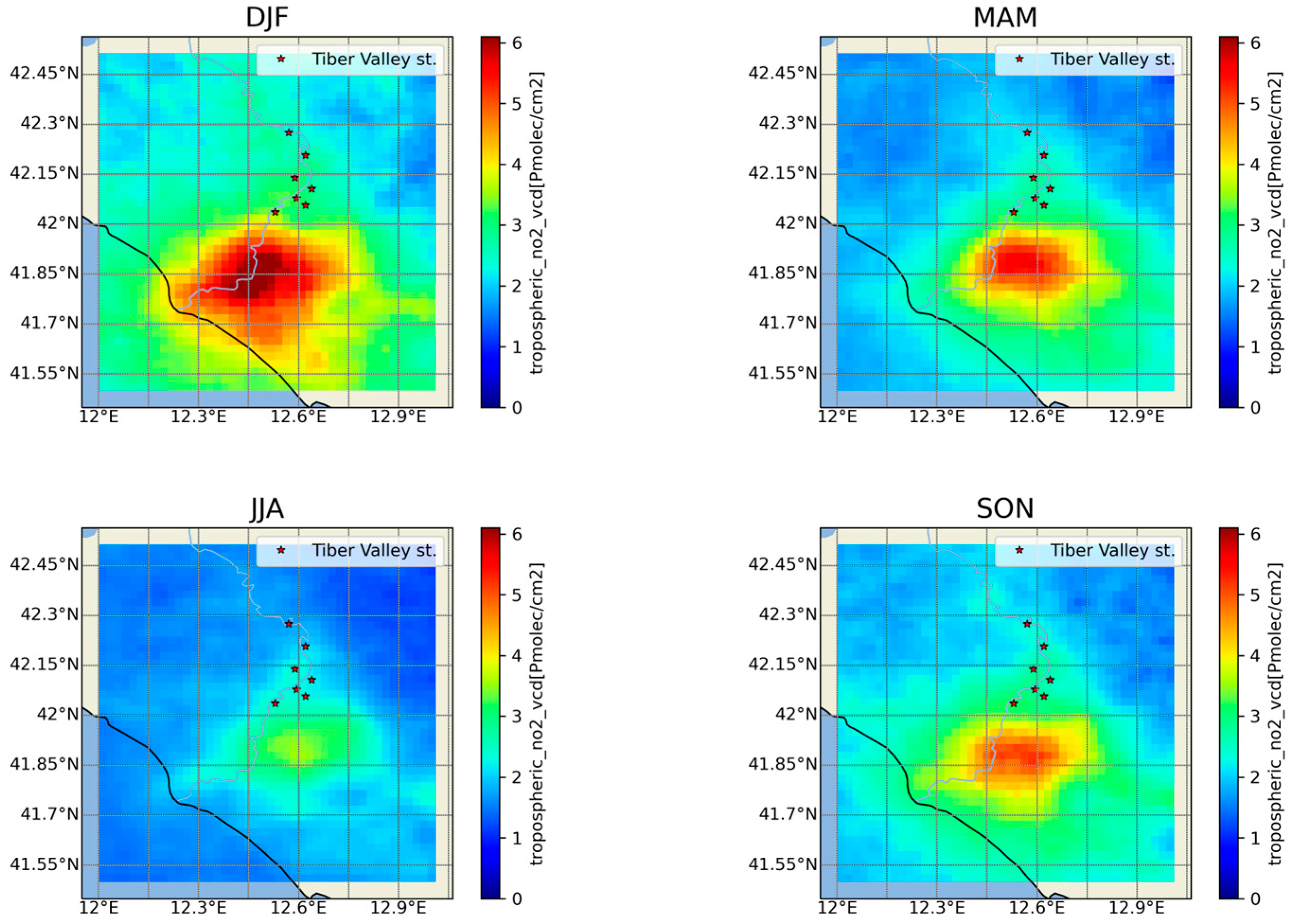
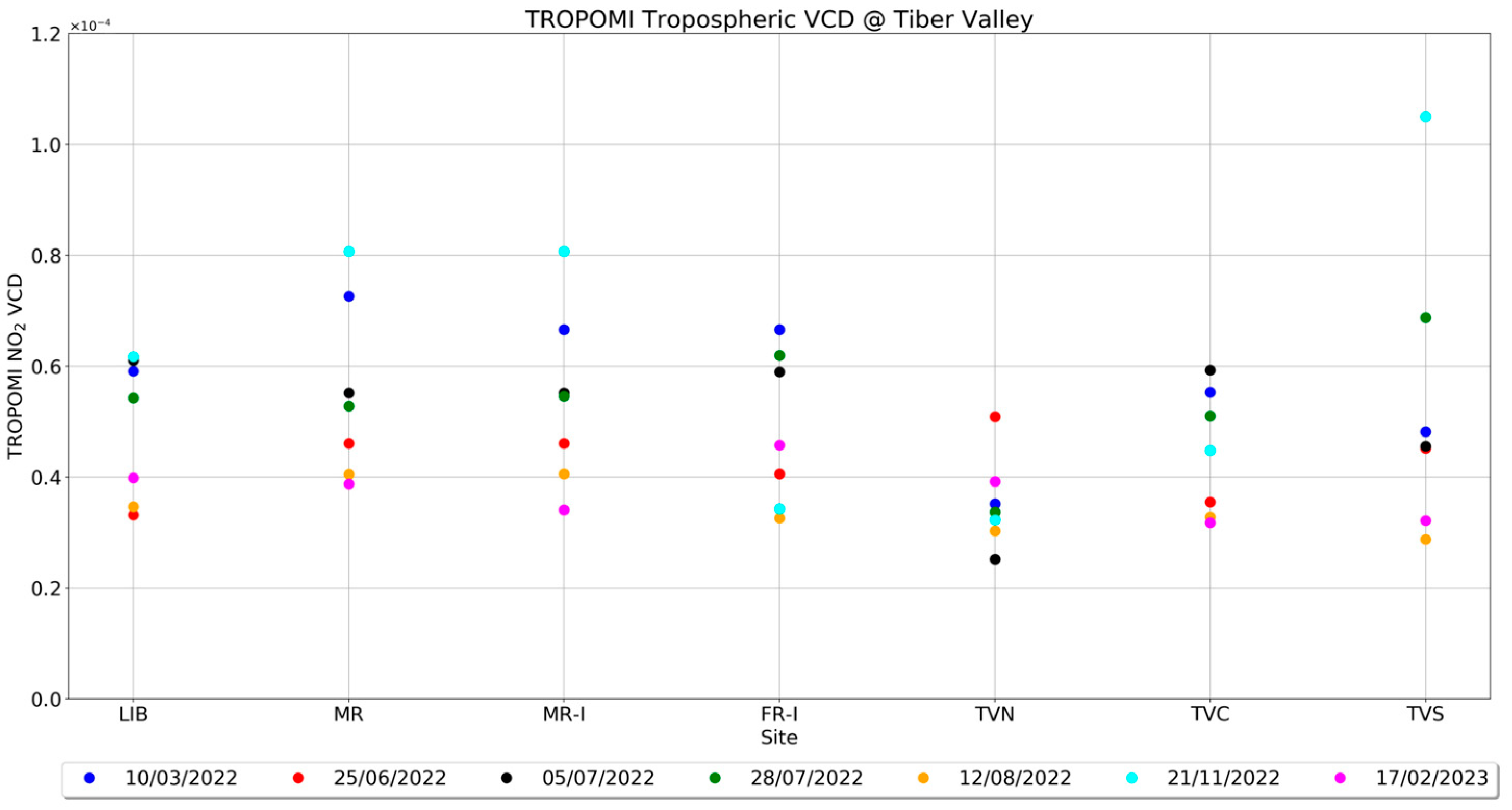
| Station | Latitude (°) E | Longitude (°) N | Label |
|---|---|---|---|
| Liberti Observatory (rural) | 42.11 | 12.64 | LIB |
| Monterotondo (residential) | 42.06 | 12.62 | MR |
| Monterotondo (Industrial) | 42.08 | 12.60 | MR-I |
| Fiano Romano (industrial) | 42.14 | 12.59 | FR-I |
| Tiber Valley North (rural) | 42.27 | 12.57 | TVN |
| Tiber Valley Center (rural) | 42.21 | 12.62 | TVC |
| Tiber Valley South (rural) | 42.04 | 12.53 | TVS |
| Before Screening | After Screening | ||||
|---|---|---|---|---|---|
| Seasonal | Parameter | Pandora | Analyzer | Pandora | Analyzer |
| DJF | Count 1 | 1150 | 1150 | 1138 | 1138 |
| Mean 2 | 1.89 × 10−7 | 1.87 × 10−7 | 1.86 × 10−7 | 1.83 × 10−7 | |
| Std 3 | 9.31 × 10−8 | 1.04 × 10−7 | 8.82 × 10−8 | 9.77 × 10−8 | |
| Min 4 | 3.62 × 10−8 | 1.59 × 10−8 | 3.62 × 10−8 | 1.59 × 10−8 | |
| Max 5 | 5.50 × 10−7 | 6.27 × 10−7 | 4.37 × 10−7 | 4.78 × 10−7 | |
| MAM | Count | 2051 | 2051 | 2025 | 1970 |
| Mean | 1.91 × 10−7 | 1.30 × 10−7 | 1.87 × 10−7 | 1.17 × 10−7 | |
| Std | 1.04 × 10−7 | 1.05 × 10−7 | 9.63 × 10−8 | 8.34 × 10−8 | |
| Min | 2.59 × 10−8 | 1.57 × 10−8 | 2.59 × 10−8 | 1.57 × 10−8 | |
| Max | 6.85 × 10−7 | 7.74 × 10−7 | 4.69 × 10−7 | 3.64 × 10−7 | |
| JJA | Count | 2525 | 2525 | 2491 | 2424 |
| Mean | 1.56 × 10−7 | 1.07 × 10−7 | 1.52 × 10−7 | 9.67 × 10−8 | |
| Std | 8.87 × 10−8 | 8.02 × 10−8 | 8.08 × 10−8 | 6.38 × 10−8 | |
| Min | 2.01 × 10−8 | 1.66 × 10−8 | 2.01 × 10−8 | 1.66 × 10−8 | |
| Max | 1.08 × 10−6 | 6.55 × 10−7 | 3.88 × 10−7 | 2.90 × 10−7 | |
| SON | Count | 1878 | 1878 | 1848 | 1834 |
| Mean | 1.74 × 10−7 | 1.71 × 10−7 | 1.69 × 10−7 | 1.60 × 10−7 | |
| Std | 9.05 × 10−8 | 1.31 × 10−7 | 8.14 × 10−8 | 9.40 × 10−8 | |
| Min | 2.04 × 10−8 | 1.66 × 10−8 | 2.04 × 10−8 | 1.66 × 10−8 | |
| Max | 8.97 × 10−7 | 2.41 × 10−6 | 4.05 × 10−7 | 4.35 × 10−7 | |
| Date (DD/MM/YYYY) | Time P (HH:MM) | P (mol/m3) | Time A (HH:MM) | A (mol/m3) | Time VCD (HH:MM) | VCD (mol/m2) | WS(m/s) | WD(°) |
|---|---|---|---|---|---|---|---|---|
| 10 March 2022 | 08:37 | 5.52 × 10−7 | 08:35 | 4.32 × 10−7 | 12:29:44 | 5.91 × 10−5 | 1.09 | 326.6 |
| 25 June 2022 | 07:56 | 3.94 × 10−7 | 07:55 | 3.12 × 10−7 | 12:22:34 | 3.32 × 10−5 | 1.31 | 64.2 |
| 5 July 2022 | 05:56 | 3.96 × 10−7 | 05:55 | 3.51 × 10−7 | 12:35:16 | 6.10 × 10−5 | 0.26 | 194.4 |
| 07:18 | 4.31 × 10−7 | 07:15 | 4.08 × 10−7 | 1.80 | 229.2 | |||
| 07:35 | 4.69 × 10−7 | 07:35 | 3.31 × 10−7 | 1.35 | 283.1 | |||
| 07:52 | 5.01 × 10−7 | 07:50 | 3.48 × 10−7 | 1.43 | 222.7 | |||
| 08:22 | 4.09 × 10−7 | 08:20 | 3.38 × 10−7 | 2.20 | 226.7 | |||
| 28 July 2022 | 05:24 | 3.98 × 10−7 | 05:20 | 3.08 × 10−7 | 12:03:59 | 5.43 × 10−5 | ||
| 05:55 | 4.60 × 10−7 | 05:55 | 3.14 × 10−7 | |||||
| 06:12 | 4.44 × 10−7 | 06:10 | 3.37 × 10−7 | |||||
| 12 August 2022 | 05:36 | 4.42 × 10−7 | 05:35 | 3.48 × 10−7 | 12:22:52 | 3.47 × 10−5 | 1.98 | 356.4 |
| 21 November 2022 | 13:29 | 5.29 × 10−7 | 13:25 | 4.46 × 10−7 | 12:29:56 | 6.17 × 10−5 | 2.35 | 215.3 |
| 17 February 2023 | 08:33 | 5.37 × 10−7 | 08:30 | 6.27 × 10−7 | 11:40:51 | 3.99 × 10−5 | 0.80 | 294.9 |
Disclaimer/Publisher’s Note: The statements, opinions and data contained in all publications are solely those of the individual author(s) and contributor(s) and not of MDPI and/or the editor(s). MDPI and/or the editor(s) disclaim responsibility for any injury to people or property resulting from any ideas, methods, instructions or products referred to in the content. |
© 2023 by the authors. Licensee MDPI, Basel, Switzerland. This article is an open access article distributed under the terms and conditions of the Creative Commons Attribution (CC BY) license (https://creativecommons.org/licenses/by/4.0/).
Share and Cite
Bassani, C.; Vichi, F.; Esposito, G.; Falasca, S.; Di Bernardino, A.; Battistelli, F.; Casadio, S.; Iannarelli, A.M.; Ianniello, A. Characterization of Nitrogen Dioxide Variability Using Ground-Based and Satellite Remote Sensing and In Situ Measurements in the Tiber Valley (Lazio, Italy). Remote Sens. 2023, 15, 3703. https://doi.org/10.3390/rs15153703
Bassani C, Vichi F, Esposito G, Falasca S, Di Bernardino A, Battistelli F, Casadio S, Iannarelli AM, Ianniello A. Characterization of Nitrogen Dioxide Variability Using Ground-Based and Satellite Remote Sensing and In Situ Measurements in the Tiber Valley (Lazio, Italy). Remote Sensing. 2023; 15(15):3703. https://doi.org/10.3390/rs15153703
Chicago/Turabian StyleBassani, Cristiana, Francesca Vichi, Giulio Esposito, Serena Falasca, Annalisa Di Bernardino, Francesca Battistelli, Stefano Casadio, Anna Maria Iannarelli, and Antonietta Ianniello. 2023. "Characterization of Nitrogen Dioxide Variability Using Ground-Based and Satellite Remote Sensing and In Situ Measurements in the Tiber Valley (Lazio, Italy)" Remote Sensing 15, no. 15: 3703. https://doi.org/10.3390/rs15153703
APA StyleBassani, C., Vichi, F., Esposito, G., Falasca, S., Di Bernardino, A., Battistelli, F., Casadio, S., Iannarelli, A. M., & Ianniello, A. (2023). Characterization of Nitrogen Dioxide Variability Using Ground-Based and Satellite Remote Sensing and In Situ Measurements in the Tiber Valley (Lazio, Italy). Remote Sensing, 15(15), 3703. https://doi.org/10.3390/rs15153703









